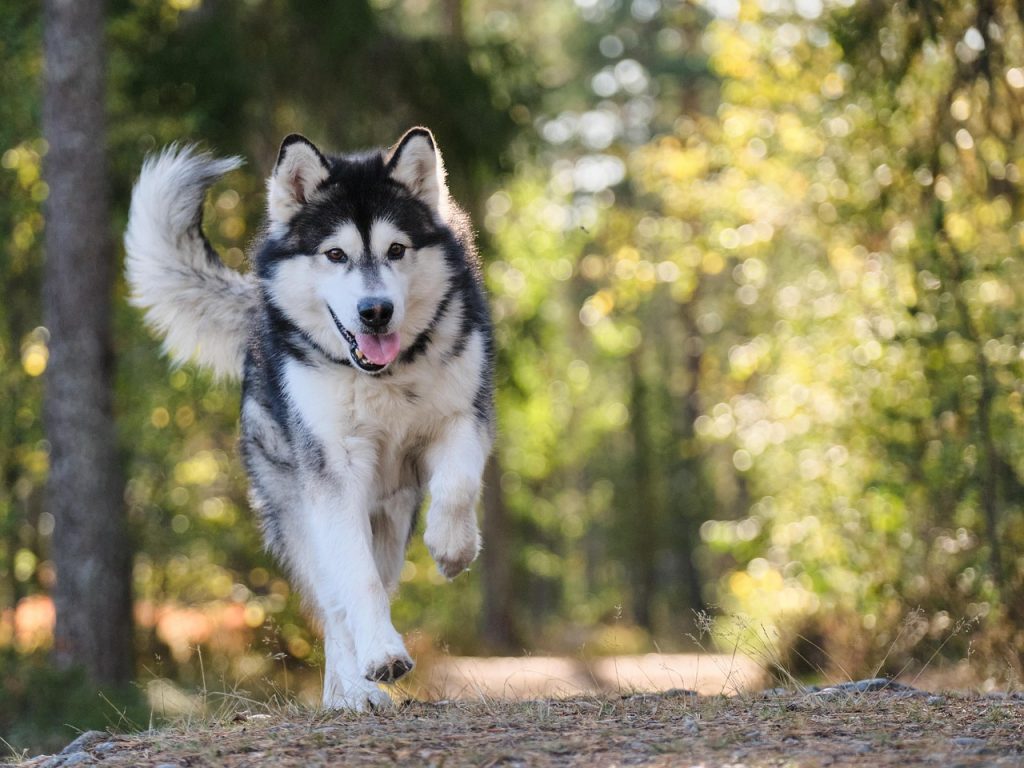The Alaskan dog, as a large working dog breed originating from the Alaska region of the United States, is loved by dog lovers around the world because of its strong physique, friendly personality, and unique gray-blue or black-and-white appearance. Before considering whether or not to raise an Alaskan dog, it is important to understand how easy it is to maintain and the strengths and weaknesses of this dog breed.
Pros of Alaskan dogs
1. Loyal and friendly character
Alaskan dogs are known for their loyalty and friendliness. They are extremely loyal to their families and are willing to do anything to protect them. At the same time, they are also generally friendly to strangers and do not attack for no reason, which makes Alaskan dogs ideal family companions. Whether playing with children or accompanying the elderly for a walk, they show great patience and gentleness.
2. Strong adaptability, suitable for outdoor activities
By originating as a working dog, Alaskan dogs have excellent adaptability and stamina. They love the outdoors and can be loyal companions whether they’re hiking, camping, or skiing. This breed not only enjoys running in nature, but also shows its superior physical strength and intelligence in these activities.
3. Easy to train and strong
learning ability
Alaskan dogs are intelligent and easy to train, and respond quickly to their owners’ commands. Basic obedience training and socialization training from an early age can help them become more well-behaved and obedient pets. In addition, due to its strong learning ability, Alaskan dogs can also learn some advanced skills, such as search and rescue, guide blind, etc., showing their potential in the field of work.
4. Beautiful appearance and unique charm
Alaskan dogs have a dense coat and signature blue-gray or black-and-white markings, which make them visually appealing. Whether walking down the street or attending a pet party, the Alaskan dog always attracts everyone’s attention and becomes the center of attention.
Disadvantages of Alaskan dogs
1. Requires a lot of movement and space
Due to their large size and high energy, Alaskan dogs need a lot of exercise and plenty of space to move around every day to release energy. If this need cannot be met, they may become restless or even destroy furniture or patios. As a result, Alaskan dogs may not be the best choice for families who live in apartments or small spaces in the city.
2. Hair removal is serious and needs to be taken care
of regularly
Alaskan dogs have a dense coat and shed a lot during the moulting season. Not only does this increase the amount of work done in the house, but it can also cause allergic reactions in family members. Therefore, regular grooming and bathing become an indispensable daily task for the care of Alaskan dogs. Owners need to have the patience and time to cope with this seasonal challenge and ensure the dog’s comfort and the cleanliness of the home. In addition, professional grooming treatments, such as trimming toenails, cleaning the ear canal, etc., are also key to maintaining a healthy appearance in Alaskan dogs and avoiding potential health problems.
3. Strong appetite, dietary management needs to be cautious
Alaskan dogs naturally have a strong appetite due to their large size and large amount of activity. If left uncontrolled, it can easily lead to overweight, which can lead to joint diseases, heart disease and other health problems. Therefore, it is crucial to have a scientific and reasonable diet plan for Alaskan dogs, including choosing high-quality dog food, feeding it in moderation, avoiding harmful ingredients in human food, etc. The owner also needs to regularly monitor the dog’s weight and physical condition, and regularly supplement the dog with aminoglucochondroitin, coenzyme Q10, etc.
So following must be considered before Raise Alaskan Dogs:
1. Choose the Right Breed for Your Lifestyle
- Alaskan Husky (Best for active owners, sledding/sports)
- Siberian Husky (High-energy, needs mental stimulation)
- Alaskan Malamute (Stronger, more independent, needs firm training)
2. Prepare Your Home & Environment
- Secure fencing (6+ feet high) – They are escape artists!
- Cool living space – Prone to overheating in warm climates
- Durable toys – To prevent destructive chewing
3. Nutrition for High-Energy Dogs
- High-protein diet (30%+ protein for active dogs)
- Omega-3 supplements (For coat & joint health)
- Avoid overfeeding (Obesity risks in inactive dogs)
4. Exercise & Mental Stimulation
- Minimum 2 hours/day (Running, hiking, sledding)
- Engage in dog sports (Skijoring, bikejoring, canicross)
- Puzzle toys & training games (Prevent boredom)
5. Training & Socialization
- Start early (Puppy classes for obedience)
- Use positive reinforcement (They respond poorly to harsh methods)
- Leash train rigorously (Strong prey drive—may chase small animals)
- Socialize with dogs & people (Prevent aggression or shyness)
6. Grooming & Coat Care
- Brush 2-3 times/week (Daily during shedding season)
- Bathe only when necessary (Overbathing strips natural oils)
- Check paws in winter (Ice buildup between toes)
7. Health Considerations
- Common issues: Hip dysplasia, eye problems (cataracts), zinc deficiency
- Vet check-ups 2x/year (Monitor joint & heart health)
- Avoid extreme heat (Risk of heatstroke)
8. Winter Care (For Cold Climates)
- Provide insulated shelter (If kept outside)
- Use dog boots (Protect paws from ice & salt)
- Increase calorie intake (Burns more energy in cold)
9. Behavioral Management
- Prevent separation anxiety (Crate training, gradual alone time)
- Discourage digging/howling (Redirect energy to activities)
- Establish pack leadership (They test boundaries)
10. Working vs. Pet Roles
- Working dogs (sledding, racing): Need intense daily exercise
- Companion pets: Still require vigorous activity but can adapt
To sum up, Alaskan dogs have become a pampered choice for many families with their unique charm, but caring for them is by no means an easy task. Before deciding to adopt, potential owners should thoroughly evaluate their own conditions to ensure that they are provided with adequate love, exercise, and professional care for this large working dog to enjoy their time with Alaskan dogs.



